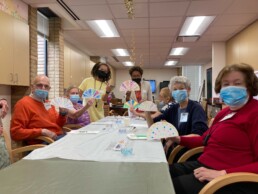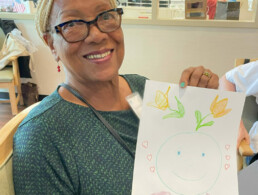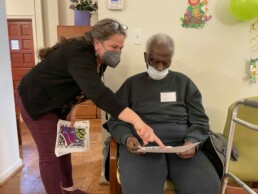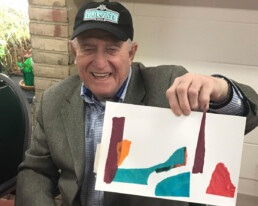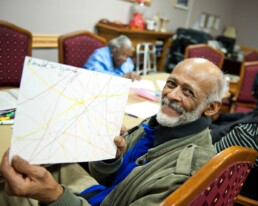On Creating A More Inclusive Arts for the Aging
Our Progress
The summer of 2020 was a time of intensified protest in the U.S. and around the world against increasing, racially motivated human and civil rights abuses. Like many businesses and organizations at that time we were shaken into recognizing that we needed to begin to fulfill our responsibilities as a cultural organization in terms of promoting diversity within, and acknowledging that we needed help to do that. As a first step in that direction, an equity cohort was formed on our board of trustees, and it was initially tasked with bringing on external consultants to lead conversations that would start us on our journey to becoming a more equitable organization in our policies and in our practices and programs.
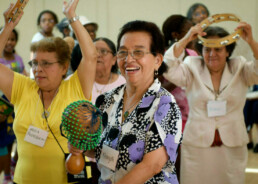
Acknowledgements & Affirmations
In the United States, there are systems of power that grant privilege and access unequally such that inequity and injustice result, and that must be continuously addressed and changed. Cultural equity is critical to the long-term viability of arts and social service sectors. We must hold ourselves accountable, because acknowledging and challenging our inequities and working in partnership is how we will make change happen. Everyone deserves equal access to a full, vibrant creative life, which is essential to a healthy and democratic society. The prominent presence of artists challenges inequities and encourages alternatives.

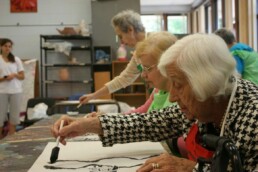
In fall 2020 through spring 2021, modeling through action, we began focusing more fundraising efforts to help support our efforts in DEIAB. We brought in expert consultants to lead cultural equity workshops for our board of trustees, staff, teaching artists, and volunteers. These included an
education series about definitions of racism, types of power, Blackness, and differences between performative and transformational engagement, and facilitated dialogue sessions around our responses to relevant cultural essays, media, and videos.
In spring 2021 our consultants conducted an organizational cultural equity assessment to help us identify, discuss, and put into action what it means to become a fully and culturally equitable organization in both policy and practice. To invite transparency and inclusivity, we opened up the board equity cohort to key stakeholders such as staff, teaching artists, and volunteers.
Our Action
To provide informed, authentic leadership for cultural equity, we strive to: Pursue cultural consciousness throughout our organization through substantive learning and formal, transparent policies. Acknowledge and dismantle any inequities within our policies, systems, programs, and services, and report organizational progress. Commit time and resources to expand more diverse leadership within our board, staff, teaching artists, volunteers, and advisory bodies.

In summer 2021 we began implementing recommendations from the organizational cultural equity assessment. We infused our therapeutic and multi-disciplinary arts programs with more multi-sensory approaches: we are creating more entry points for engagement with participants impacted by varying health conditions in aging; for example we use audio descriptions as well as closed captioning for increased inclusivity. We began recruiting more teaching artists with diverse backgrounds, arts disciplines, and who are multi-lingual. We prioritized, and continue to do so, intentional reach to historically marginalized communities and stakeholders as we aim to diversify organizationally and expand accessibility.

“Our work in cultural equity is foundational to Arts for the Aging’s mission, goals, activities, and ways we relate to one another, and is centered around principles that unite program participants, teaching artists, board, staff, advisors, volunteers, clients, and partners—all of us.”
— Director & CEO, Janine Tursini

In fall 2021 our equity cohort began meeting for what we call equity jams. We used a series of these meetings to reframe our organizational statements of mission, vision, values, and beliefs using a lens DEIAB. We wrote our statements on cultural equity together, leveraging resources from advocates at the national level, AmericansfortheArts.org.
Equity Committee
Equity committee membership is open to all Arts for the Aging personnel and volunteers who wish to be part of ongoing conversations and work in equity, diversity, inclusion, accessibility, and belonging (DEIAB). The committee is comprised of members of the board, staff, teaching artists, and volunteers and meets quarterly. They meet as often as do other board committees, four times annually. This committee’s purpose is to regularly explore DEIAB issues; help center it in our culture, structure, practice, and programs; set benchmarks, evaluate progress, and communicate transparently about goals; and encourage learning and building cultural competencies through continued dialogue.
Statement on Cultural Equity
To pursue needed systemic change related to equity, we strive to: Encourage substantive learning to build cultural consciousness and to proliferate pro-equity policies and practices by all of our constituencies and audiences; improve the cultural leadership pipeline by creating and supporting programs and policies that foster leadership that reflects the full breadth of American society; consider and incorporate quantitative and qualitative research and evidence related to equity to make incremental, measurable progress towards cultural equity more visible; advocate for public and private-sector policy that promotes cultural equity.

In spring 2022 organizational diversity statements were adopted by our trustees, and the equity cohort became a standing committee of the board of Arts for the Aging.
In fall 2022 we conducted a survey of clients and participants, which changed significantly during the covid-19 pandemic, to benchmark our work and help ensure expansion with a focus on DEIAB.
In early 2023 we published data illustrating our impact and reach in Greater Washington, D.C.
In 2023-2024, we are moving ahead with our board equity
committee as we fuel organizational and field progress.
Our Land Acknowledgement
Every community owes its existence and strength to the generations before them, around the world, who contributed their hopes, dreams, and energy into making the history that led to this moment. Some were brought here against their will, some were drawn to migrate from their homes in hope of a better life, and some have lived on this land for more generations than can be counted. Truth and acknowledgment are critical in building mutual respect and connections across all barriers of heritage and difference. Arts for the Aging believes it is important to create dialogue to honor those that have been historically and systemically disenfranchised.
So, we acknowledge the truth that is often buried: Arts for the Aging’s administrative offices and program sites are on the ancestral lands of the Piscataway People, who were among the first in the Western Hemisphere. We are on indigenous land that was stolen from the Piscataway People by European colonists. We pay respects to Piscataway elders and ancestors. We take this moment to consider the many legacies of violence, displacement, migration, and settlement that have brought us here today.
“Our goal is to create an organization that is welcoming and inspires a sense of belonging at all levels to people with diverse abilities and backgrounds.”
— Board Chair (2019-2023), Don Wright



